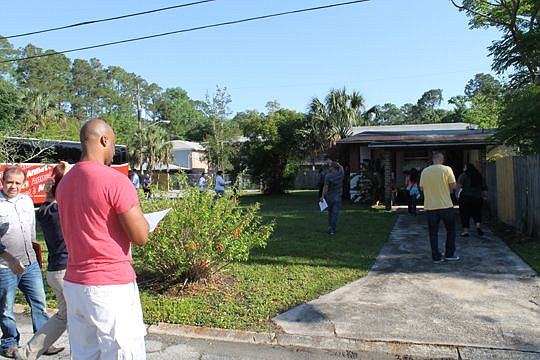
New investors often have trouble estimating rehab costs. How many get it wrong?
“Almost all of them,” said Cameron Gaskill, an investor and contractor who’s renovated more than 600 houses.
Within a few minutes, his point became evident. At the end of a bus tour of rehabs in Jacksonville, Gaskill compared notes with his students.
“How many of you estimated the repair cost at under $15,000?” he said for the first home, a 1,148-square-foot block construction in Englewood with badly damaged hardwood floors, no HVAC, a gutted kitchen, and missing doors and light fixtures.
No hands went up.
“How many said $15,000 to $20,000?” Gaskill said. A few hands appeared.
$20,000 to $25,000? More hands. $25,000 to $30,000? $30,000 to $35,000? Hands went up for every price group through $50,000 and above.
Only one student out of 86, though, picked the price range that matched Gaskill’s estimate of $35,255.
“The floor was what screwed me up,” said Peter Martin, who had guessed above $50,000. “I was scared I’d have to replace the whole thing.”
A three-day Jacksonville boot camp and bus tour for investors was held recently.
Sponsored by the Jacksonville Real Estate Investors Association, the training allows new investors to learn the business from local veterans.
The classwork spans such topics as finding leads, financing deals and marketing homes. But a bus tour where students see actual rehabs and compare repair estimates with their instructors is a key lesson, former students say.
Maryanne Markowski took the training last year.
Since then, she’s purchased two buy-and-hold properties. One of them she rehabbed and she is looking at another rehab deal now.
Until last year, Markowski was a novice who had been learning from books. The JaxREIA course brought all the pieces together, she said.
“To me there’s no substitute for boots on the ground, actually looking at properties, assessing damage and making estimates,” she said. “If you don’t have that solid foundation, you can’t purchase at the right price.”
Kahl McDevitt attended the association’s first boot camp in 2012, about a month after he joined JaxREIA.
“I was so new, I barely knew how to spell real estate,” he said. “It vaulted me forward 10 times as fast as I would have progressed.”
He learned some things he’d never heard of before. Like how staging homes will increase buyer interest and how it’s possible to borrow money from an IRA to finance a deal.
Now, McDevitt is a wholesaler — an investor who flips houses to other investors. His goal is to own five rentals, one to leave to each grandchild.
He already owns the first one. It earns enough rent to pay the mortgage and cash-flow an extra $165 apiece to him and his partner.
At his first boot camp, McDevitt’s team missed the repair cost on the final exam rehab by $10,000.
The windows had moisture in them and needed to be reglazed or replaced.
“There were 14 windows at $300 apiece. That was a major thing we missed,” he said.
Since then, McDevitt has returned for two other boot camps. He called the bus tour fantastic.
“It’s where the rubber meets the road. … It gave us reality data on what a rehab takes,” he said.
Missing a repair will throw off a cost estimate. But at this year’s boot camp, repair costs weren’t the only information students sought.
Gonzalo Corzo has done about 30 wholesale deals and is looking to flip his first house.
“You can get rehab estimate sheets online,” he said. “I came to learn the little details.”
He means things actual investors think of when they size up a deal.
Like how to check for aluminum wiring if replacing an electrical panel. And that a special type of wire nut should be used to join aluminum wiring with copper.
For one of the houses, Corzo didn’t think much about the apartment complex next door until Gaskill mentioned it.
“When we were walking through, Cameron said, ‘Why did everybody analyze this house as a retail flip? This is a rental market,’” Corzo said.
About 80 percent of new real estate investors fail within two years, said Gaskill, usually for lack of money or education.
As detailed as the boot camp seems, it’s still really an introductory course. A lot of the students are inexperienced investors. Many will come back several times.
“They often have a lot of misconceptions about real estate investing that they’ve gotten from watching house flipping programs on TV,” Gaskill said. “We kind of reboot them.”
A class is often not enough. JaxREIA’s veterans encourage newer members to work with a mentor in the beginning.
And, continue getting educated.
In his first five years in real estate, Gaskill said, he refused to buy real estate courses and programs, because he thought they were just scams.
Then, he took a course. He made $81,000 on his first deal after that.
“After that I realized, those courses were beneficial,” he said.